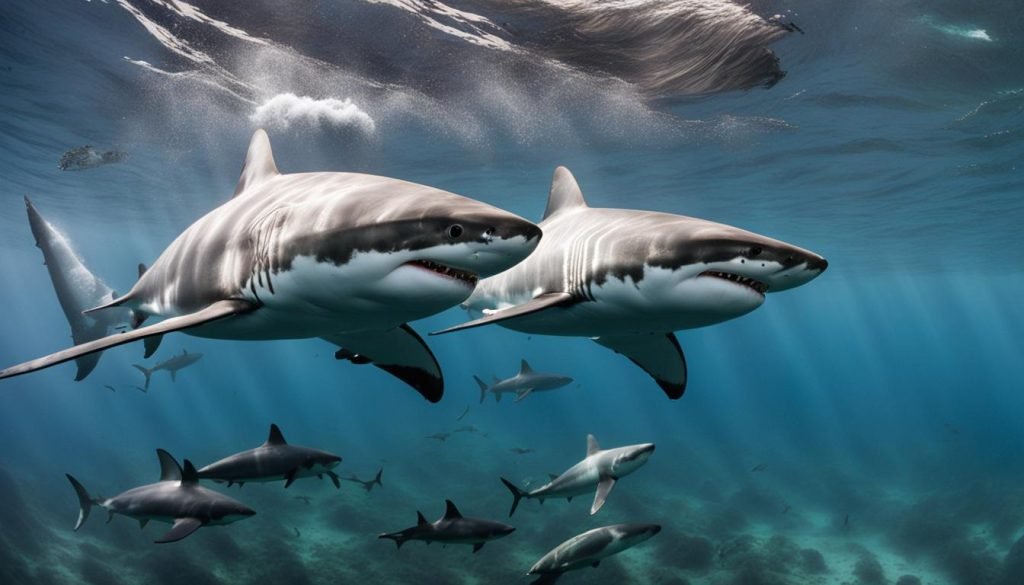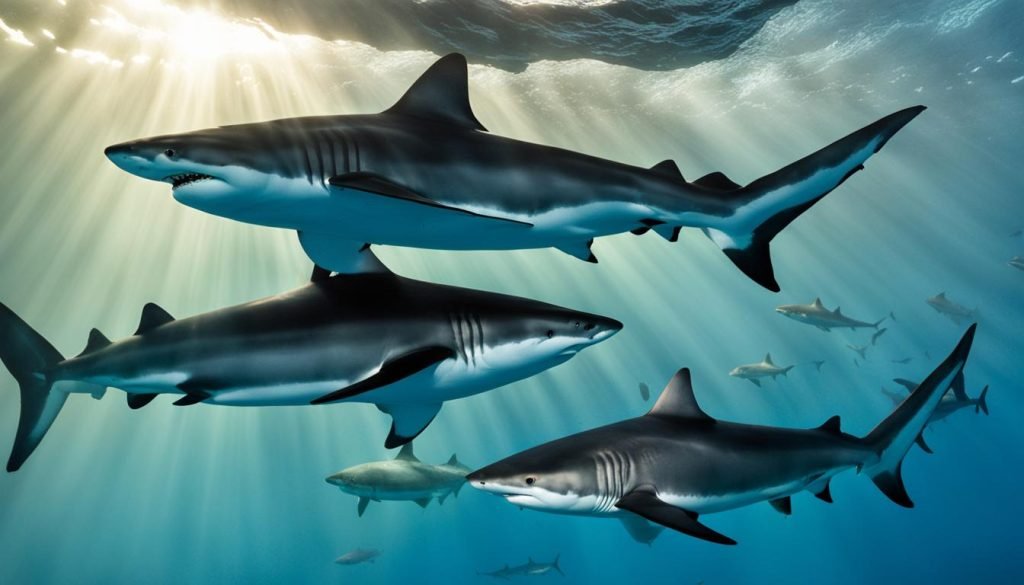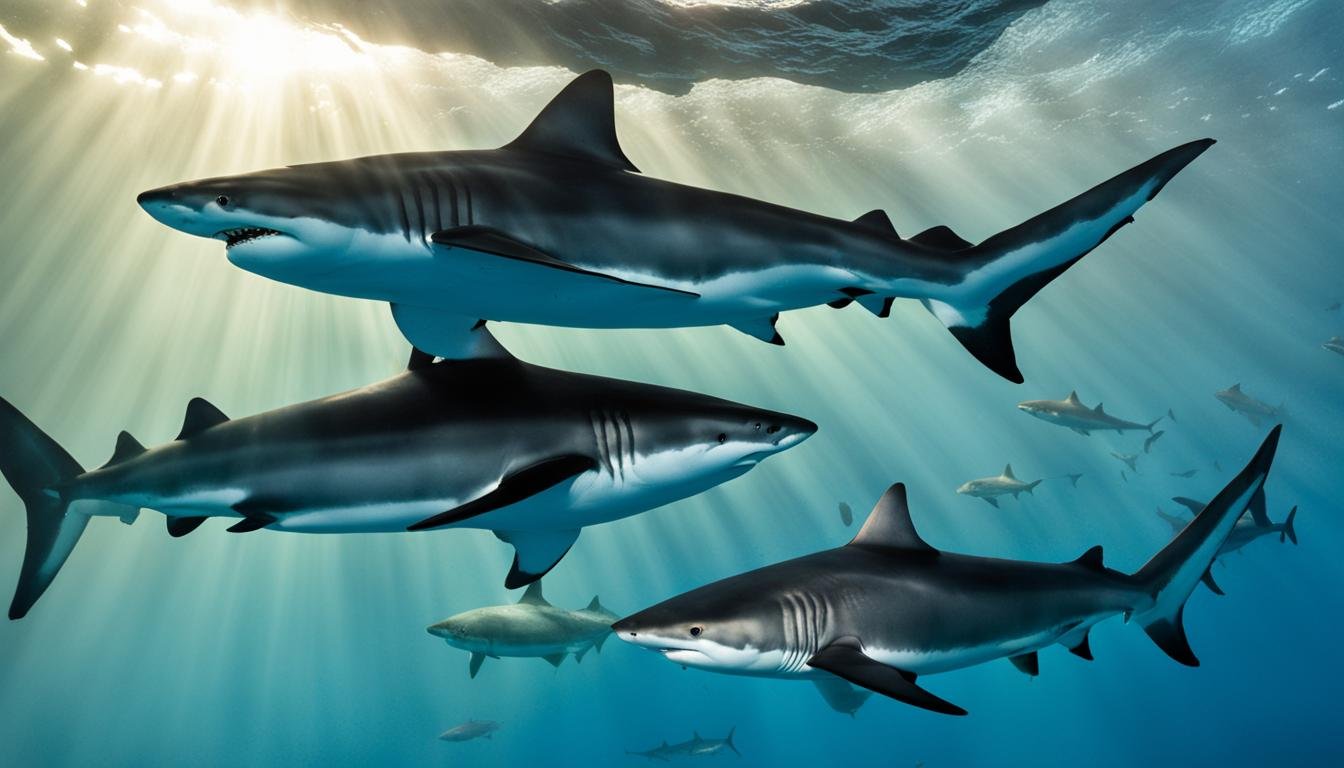How Do Sharks Mate? – Mating Process Explained
Welcome to our article on the fascinating world of shark mating!
In this piece, we’ll delve into the intricate behaviors and processes that sharks utilize for successful reproduction. Sharks are an intriguing species that reproduce through sexual reproduction, with distinct mating behaviors and breeding habits. We’ll explore their mating rituals, courtship behaviors, and the overall process of how sharks mate.
Understanding how sharks mate is critical in protecting and managing their populations. This knowledge allows for better conservation efforts and helps us understand the role that sharks play in their respective ecosystems. So, let’s explore the world of shark sexual reproduction and uncover how these incredible creatures continue to thrive in their environments.
Key Takeaways:
- Sharks reproduce through sexual reproduction
- Mating behaviors and breeding habits are crucial for successful reproduction
- Courtship and mating rituals play a significant role in the mating process
- The mating process includes specific techniques for successful fertilization
- Environmental and biological factors influence shark mating patterns and reproductive cycles
How Do Sharks Mate: Understanding Shark Reproduction

Sharks are unique creatures that reproduce through sexual reproduction, with distinct mating behaviors and breeding habits. Understanding the basics of shark reproduction is important before discussing the specifics of shark mating.
Most shark species reproduce through internal fertilization, where a male shark inserts one of its claspers into the female’s cloaca. The cloaca is an opening in the female’s body through which urine, feces, and eggs are released. The male then releases sperm through his clasper, fertilizing the eggs internally.
Sharks are oviparous, ovoviviparous, or viviparous, with each term indicating how the embryos are developed before birth. Oviparous sharks lay eggs outside the body, where the young develop until they hatch. Ovoviviparous sharks retain the eggs inside the body until they are ready to hatch, at which point the young are born live. Finally, viviparous sharks carry the developing embryos inside the body until they are born alive.
Shark mating behavior and breeding habits vary depending on the species, with some species migrating to specific areas for mating while others mate year-round. Some species engage in elaborate courtship rituals before mating, while others mate more opportunistically.
Males often demonstrate their dominance over females before mating, with displays of strength such as biting or head-butting. Females may also exhibit certain behaviors to attract a mate, such as swimming in a particular way or releasing pheromones.
The reproductive cycle of sharks varies between species, with some sharks only reproducing every few years while others reproduce annually. The size of the litter also differs between species, with some sharks giving birth to only a few offspring while others give birth to dozens or even hundreds at once.
“Sharks have been around for over 400 million years, and their reproductive strategies have evolved over time to ensure their survival in a constantly changing environment.”
Shark Quiz
How well do you know sharks? Test your knowledge below!

Courtship and Mating Rituals of Sharks

Sharks are masters of courtship and mating rituals, employing a variety of behaviors to ensure successful reproduction. These rituals can range from aggressive displays of dominance to intricate courtship dances that are unique to each species.
Male sharks often engage in displays of aggression to assert dominance and attract a mate. These displays can include biting, head-butting, and tail-slapping, and are intended to demonstrate the male’s strength and fitness. In some species, males also use their teeth to hold onto the female during mating, which can lead to scars and injuries on the female’s body.
Female sharks, on the other hand, tend to be choosy when it comes to selecting a mate. They will often assess the male’s fitness and genetic quality before engaging in the mating process. Some species of female sharks have even been observed engaging in courtship dances, circling and rubbing against the male in a slow, rhythmic fashion.
One particularly fascinating courtship ritual is observed in the lemon shark species. Here, males and females swim together side by side, with the male positioning himself slightly ahead of the female. The male then bites down gently on the female’s pectoral fin and leads her through a series of twists and turns, culminating in the act of mating.
Overall, the courtship and mating rituals of sharks are fascinating and varied, with each species exhibiting unique behaviors and adaptations. These behaviors are crucial to the success of shark reproduction and ensure the continuation of these incredible creatures for generations to come.
The Shark Mating Process
Shark mating is a complex process that involves intricate behaviors and specialized techniques to ensure successful fertilization. Depending on the species, sharks may engage in a variety of mating techniques, including biting, clasping, and inserting claspers into the female’s cloaca.
The shark mating process typically begins with the male shark approaching the female and biting her to assert dominance. This biting behavior may seem aggressive, but it is actually a crucial part of the mating process. By biting the female, the male releases hormones that stimulate her reproductive system and increase the chances of successful fertilization.
Once the male has asserted dominance, he will attempt to use his claspers to insert sperm into the female’s cloaca. The claspers are specialized reproductive organs located on the underside of the male’s body. They are used to transfer sperm to the female during mating.
The female shark has control over whether or not she accepts the male’s advances. If she is receptive to mating, she will hold still while the male inserts his claspers. If she is not interested, she may swim away or attack the male to defend herself.
After successful fertilization, the female will carry the fertilized eggs until they are ready to hatch. The length of the gestation period varies depending on the species of shark and can range from a few months to over a year.
It’s important to note that not all shark species mate in the same way. Some species engage in more elaborate courtship behaviors, while others have more straightforward mating techniques. Additionally, environmental factors such as water temperature and seasonality can impact the mating process and breeding habits of sharks.
Factors Influencing Shark Reproduction

Shark breeding habits and the reproductive cycle are crucial factors that impact shark mating patterns. The environmental and biological factors that influence these behaviors are complex and multifaceted, ranging from seasonal changes to genetic diversity.
Some shark species, such as the tiger shark and great white shark, have distinct breeding habits that involve traveling long distances to specific mating grounds. These grounds provide a vital environment for courtship and mating, and the timing of these migrations is often influenced by seasonal changes in water temperature and food availability.
Additionally, the reproductive cycle plays a crucial role in shark mating patterns. Many species have a slow reproductive cycle, with low fecundity rates and extended gestation periods. This factor can limit the abundance of shark populations and their ability to recover from environmental disturbances or human impacts.
Moreover, genetic diversity is a critical component of successful shark reproduction. Inbreeding and genetic bottlenecks can reduce the fitness and resilience of shark populations, making them more vulnerable to disease, habitat loss, and other threats. To ensure the long-term survival of sharks, researchers and conservationists must understand the complex interplay of these factors and develop effective management strategies to protect these magnificent creatures.
Unique Adaptations for Successful Mating
Sharks have evolved numerous adaptations to facilitate successful mating. Some of the most intriguing adaptations are related to their reproductive systems and behaviors. For instance, male sharks possess claspers that are modified pelvic fins used to transfer sperm to the female’s reproductive tract. Similarly, females have reproductive tracts that are specially adapted to receive and store sperm for extended periods, ensuring successful fertilization even when mating opportunities are rare.
Sharks also exhibit unique behaviors during courtship and mating to ensure successful reproduction. For example, some species engage in elaborate courtship dances, while others display dominance through aggressive behaviors such as biting and thrashing. These behaviors not only facilitate successful coupling but also serve to ensure the survival of the fittest offspring, as the strongest and most genetically diverse pairings are more likely to produce healthy offspring with better chances of survival.
Another fascinating adaptation of sharks is their keen sensory abilities. Certain species of sharks have highly developed electroreceptors, which allow them to detect the faint electrical signals produced by other organisms, including potential mates. Additionally, sharks can use their sense of smell to locate potential mates from long distances, often migrating to specific mating grounds to increase their chances of successful reproduction.
Finally, sharks have also evolved specialized reproductive cycles that are adapted to their specific environments and mating patterns. For instance, some species exhibit seasonal breeding habits, while others mate year-round. Additionally, some species have developed complex migrations patterns to reach specific mating grounds, while others prefer to mate in nearshore waters.
In conclusion, the unique adaptations of sharks for successful mating are a testament to their evolutionary success as a group. From their reproductive systems to their mating behaviors and sensory abilities, sharks have evolved a variety of adaptations that enable them to continue their species and thrive in their environments.
The Future of Shark Mating Research
As scientists delve deeper into the world of shark mating, new insights are continually emerging, providing a better understanding of the reproduction cycle and mating process of these remarkable creatures.
The Importance of Ongoing Research
Ongoing research into shark mating is crucial to better understand the factors influencing their reproductive patterns and to develop conservation and management efforts to ensure the survival of shark populations.
In recent years, advancements in technology have allowed for more sophisticated studies, such as genetic analysis, to help uncover the mysteries of shark mating. Additionally, the use of underwater cameras and tracking devices has enabled scientists to observe and record mating behaviors and patterns in their natural habitats.
Implications for Shark Conservation
Understanding the reproductive cycle and mating process of sharks is critical for the conservation and management of shark populations. By identifying mating grounds and breeding habits, conservation efforts can be targeted to protect vulnerable populations and maintain genetic diversity.
Furthermore, knowing the mating behaviors and patterns of sharks can help manage human-shark interactions. For example, certain times of the year may see an increase in shark activity due to mating patterns, leading to higher instances of shark-human interactions. By better understanding these behaviors, we can better adapt to coexist with these fascinating creatures.







